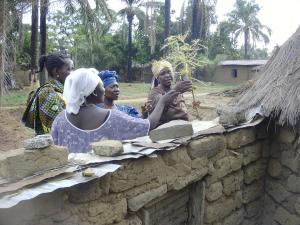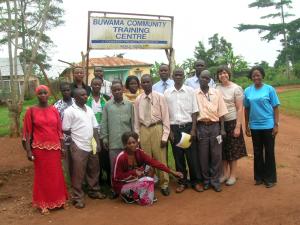GEM is an evaluation methodology that integrates a gender analysis into evaluations of initiatives that use ICTs for social change. It is an evaluation tool for determining whether ICTs are really improving or worsening women’s lives and gender relations, as well as for promoting positive change at the individual, institutional, community and broader social levels.
GEM has been developed from the ground up, and has involved the collaboration of hundreds of community-based organisations and individuals since its first design in 2002. The network that has developed includes people who developed GEM, who train in how to use GEM, who are adapting GEM (to increase its applicability to rural ICT4D projects, telecentres, software localisation and ICT policy advocacy, and who are now offering GEM evaluations on a consultancy basis.
What the network says about GEM GEM and Fantsuam Foundation
GEM and Fantsuam Foundation
Photo: The Fantsuam Foundation began as a microcredit scheme offering loans to local women. ICTs are fundamental to their work and Fantsuam ha been involved testing and using GEM since its inception. Photo by Fantsuam Foundation
Reports confirm that GEM produces a real change in the mindset of evaluators and users themselves and this consciousness remains with them.
John Dada is a farmer, nurse and part-time coordinator at the Fantsuam Foundation. Fantsuam is based in rural Nigeria. The foundation began as a micro-credit scheme offering credits to the local women. ICTs are a fundamental part of their work and while Fantsuam had been involved in GEM since its inception, John was only directly engaged in GEM when he attended a GEM workshop for telecentre and rural ICT projects in 2007. He reported: “I am suddenly seeing GEM everywhere, in everything I do. I suppose that is what you mean by being gender-sensitive, that you don’t take things for granted any more. You begin to appreciate why sometimes the women that are part of our community resist the empowerment process and want to do things as they have always done. I used to be annoyed and think, ‘Can’t you see that you are oppressed? Can’t you see that you are being cheated?’ Now I understand that this is the product of years of conditioning and it will take some effort to reverse the trend. With GEM, you pull away all of the cultural cover-ups, social constructs and biases and you see the situation for what it truly is. And it is only when you appreciate the truth of a situation, that you can actually effect any change. Otherwise you just scratch the surface. GEM helps you see the situation for what it is, so you can optimise your resources where you can make the maximum impact in creating change.”
Natasha Primo facilitated a GEM workshop convened by the IDRC for its African grantees running ICT-related projects. She recounts her experience when she realised the impact that GEM could have on the mindset of ICT project coordinators: “The workshop participants had very different takes on how their projects were already gender-aware. Some flatly argued that gender was irrelevant to their projects. We wanted to create a common understanding that their research should be aimed at making the world a better place for citizens or communities or children and that where they did not acknowledge gender and the impact gender would have on their research subjects’ lived experience, they could well be entrenching inequality.
“As participants grappled with their research questions they began to have a sense of how they could integrate – or could have in some cases – a gender lens. There was one participant who seemed really disengaged from the workshop process, but when he reworked his research questions to be gender-aware, he was the one most struck by how a re-orientation of the project approach to accommodate more participatory local government and especially participatory budgeting processes would have had a profound impact on the ability of women citizens to engage with their local government.
“For the participant, his project morphed from a computer and software-enabled information management project into a (lost) opportunity to pilot a project that deepened women’s role in local budget discussions with the potential to impact on decision making.”
Who is using GEM?
By 2004 a total of 103 women and nineteen men from 36 countries had been trained in how to apply GEM. In the following four years sixteen organisations requested GEM training and over 300 people were trained through these workshops. In addition, since 2007, twelve organisations have been adapting GEM in the four thematic areas, for application to rural ICT4D projects, telecentres, software localisation and ICT policy advocacy.  GEM users in Uganda
GEM users in Uganda
Photo: On Lake Victoria, the Buwama Telecentre was mainly used by journalists from the local radio station and teenagers. Following GEM training, journalists have begun to create programming that includes women’s perspectives and caters better to the needs and interests of local women. The telecentre administrators have also begun to offer equal opportunity ICT training and encourage the participation of women over 30. Photo by APC WNSP
Those organisations include CEPES, an APC member from Peru working with rural communities west of Lima. Colnodo, an APC member from Colombia, works with hundreds of municipalities helping them ensure their transparency by getting their financial information online and is implementing GEM in a number of government telecentres. Telecentre networks in the Philippines, Mali, Colombia and Uganda are learning about how their projects can change gender roles and relations in their communities. A long-standing GEM partner has produced a guidebook on gender and technology in Bangladesh. An academic in Chhattisgarh, India has made GEM part of the coursework at the university where she works and joined the APC delegation to the IGF in India, leading our intervention during an informal consultation with Indian government officials.
There was also a demand for GEM consultancies. The GEM team completed eight major consultancies during 2004-2008, ranging from training gender national machineries under the United Nations Division for the Advancement of Women (UNDAW) in Africa to integrating gender into research and ICT4D projects run by the Ministry of Commerce in Cambodia.
“For the participant, his project morphed from a computer and software-enabled information management project into a (lost) opportunity to pilot a project that deepened women’s role in local budget discussions with the potential to impact on decision making.”
“In the last five years, we have worked with many people and organisations. Some we trained only in one workshop, others we guided through evaluations. Some we have not heard from again. Many others we are still in touch with and we continue to support,” says women’s programme coordinator Chat Garcia Ramilo. “What we have discovered is that this overall process of capacity building takes a long time, but if we persist long enough, we find out what changes it brings about.”
This content has been adapted from the “APC Progress Report 2004-2008”:http://www.apc.org/en/node/9153/.